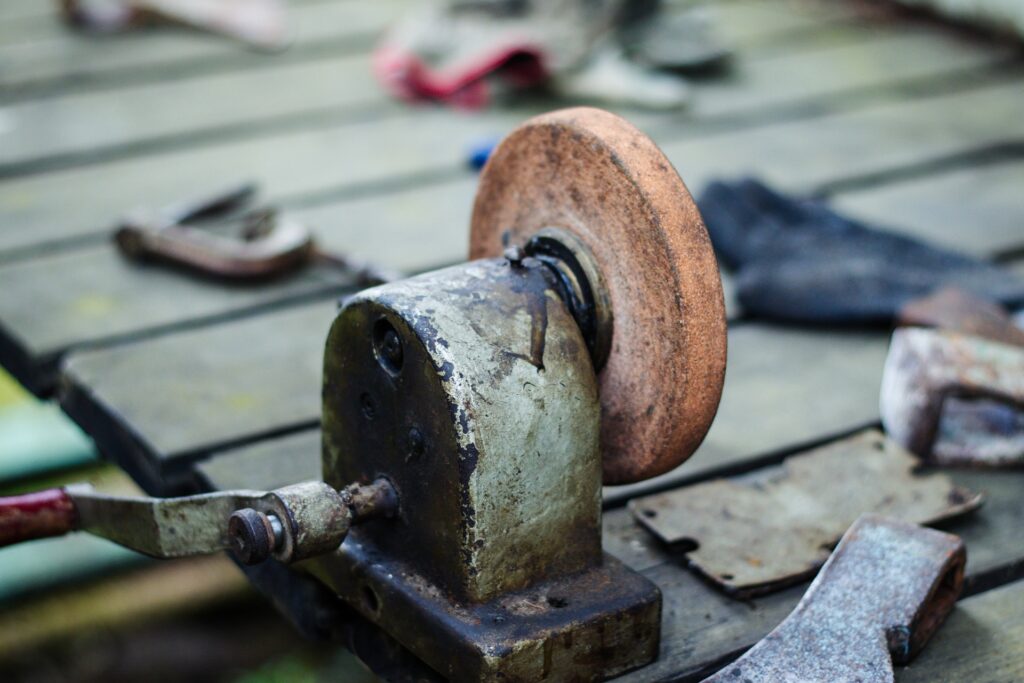Blog
The Art of Sharpening Tools: Techniques and Tools

Sharpening tools is an ancient craft that has evolved over millennia, yet remains fundamentally unchanged in its objectives: to produce a keen edge that improves the performance of a cutting tool.
Whether you’re a carpenter, a chef, a gardener, or an enthusiast in any other discipline that relies on sharp tools, mastering the art of sharpening is essential. This blog post will explore the techniques and tools involved in sharpening, providing you with the knowledge to maintain your tools in top condition.
Understanding the Basics of Sharpening
Sharpening is the process of removing material from a tool’s edge to produce a sharp point. It involves two stages: grinding and honing. Grinding removes old metal and creates the new edge, while honing polishes the edge to refine its sharpness. The ultimate goal is to create a junction of two planes that results in a razor-sharp edge.
Selecting the Right Sharpening Tools
The most common sharpening tools include whetstones, diamond stones, honing steels, and strops. Each has its own advantages:
Whetstones: These are the most traditional sharpening tools. They come in different grits, ranging from coarse for grinding to fine for honing. Japanese waterstones, which require soaking in water before use, are renowned for their ability to produce an extremely sharp edge.
Diamond Stones: These are metal plates embedded with diamond particles. They cut very fast and don’t wear down like whetstones, making them a durable option. However, they can be too abrasive for some delicate tools.
Honing Steels: Often found in kitchens, these are rods of steel or ceramic used to maintain the edge of knives between sharpenings.
Strops: A strop is typically a piece of leather used after honing to polish the edge and remove any remaining burr. It’s the final step in sharpening, providing a razor-sharp finish.
Techniques for Sharpening Tools
The techniques for sharpening tools vary slightly based on the tool being sharpened but the principles are similar.
Preparing the Stone: If using a whetstone or waterstone, it’s important to prepare it by flattening the stone with a lapping plate or flattening stone. This ensures an even sharpening surface.
Finding the Angle: The sharpening angle is crucial. A lower angle results in a sharper but weaker edge, while a higher angle yields a stronger but less sharp edge. For most tools, an angle of 20 to 30 degrees is ideal.
The Sharpening Process:
Grinding: Hold the tool against the stone at the correct angle and move it back and forward across the stone with even pressure. Start with the coarse grit to shape the edge.
Honing: Switch to a finer grit stone and repeat the process to refine the edge.
Stropping: Drag the edge backward across the strop, away from the cutting edge, to polish it and remove any burr.
Maintaining a Consistent Angle: It’s vital to maintain the same angle throughout the sharpening process. Tools like angle guides can help, but with practice, you’ll develop a feel for it.
Using Lubrication: Water or oil is used on some stones as lubrication to carry away the metal filings (swarf) and reduce heat from friction.
Sharpening Different Tools
Different tools require slightly different techniques:
Knives: Use a consistent angle and a combination of whetstone grits. Finish with a honing steel and a strop for an exceptionally sharp edge.
Chisels and Plane Blades: These require a flat edge, so they’re often sharpened with a honing guide to maintain the angle. Finish with finer grits and a strop.
Axes and Garden Tools: These are typically sharpened with a file to grind the edge, followed by honing with a finer stone or diamond sharpener.
Advanced Sharpening Tips
Compound Angles: Some tools, like certain knives, benefit from a compound angle, where the edge has two different angles for durability and sharpness.
Mirror Finish: For the ultimate in sharpness, some artisans polish the edge to a mirror finish using ultra-fine grit stones or compounds.
Rust Prevention: After sharpening, it’s a good practice to oil the tool to prevent rust, which can dull an edge.
Caring for Your Sharpening Tools
Proper care will extend the life of your sharpening tools. Keep your tools clean, dry, and stored in a moisture free environment. Flatten your whetstones regularly to ensure they remain effective.
Safety Considerations
When sharpening tools, always prioritize safety. Use a stable work surface, wear protective gloves if necessary, and keep your fingers clear of the blade’s path.
Conclusion
The art of sharpening is a skill that rewards patience and attention to detail. With the right sharpening techniques, you can ensure that your cutting tools are always in peak condition, making your work more efficient and enjoyable. Remember, a sharp tool is a safe tool, as it requires less force to use and is less likely to slip. Take the time to learn and practice sharpening, and you’ll find it to be a meditative and satisfying addition to your craft.
More reading
Comparing Corded vs. Cordless Power Tools